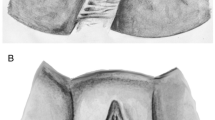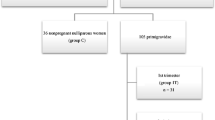Abstract
Introduction and hypothesis
Aim of this study is to investigate pelvic floor muscle pain scores in a group of healthy, asymptomatic, nulliparous women using a simple visual analogue scale, and to examine the inter-rater and test–retest reliability of the digital palpation of the pelvic floor muscle.
Methods
Seventeen female volunteers were recruited. Different sites of their pelvic floor muscle were examined digitally according to the suggestions of the International Continence Society from two investigators blinded to the clinical data in two consecutive visits and pain scores were obtained. Level of agreement between investigators, inter-rater and intra-rater reliability were assessed.
Results
Overall pain scores were low. There were statistically significant differences between scores at different pelvic sites, with the levator ani showing the lowest scores. Reliability was heterogeneous among pelvic sites, varying from poor to excellent.
Conclusions
Pain upon palpation of the pelvic floor muscle in asymptomatic, nulliparous women should be considered an uncommon finding.

Similar content being viewed by others
References
Tu F, As-Sanie S, Steege J (2006) Prevalence of pelvic musculoskeletal disorders in a female chronic pain clinic. J Reprod Med 51:185–189
Fitzgerald CM, Neville C, Mallinson C, Badillo S, Hynes C, Tu F (2011) Pelvic floor muscle examination in female chronic pelvic pain. J Reprod Med 56:117–122
Messelink B, Benson T, Berghmans B et al (2005) Standardisation of terminology of Pelvic Floor Clinical Assessment Group of the International Continence Society. Neurourol Urodyn 24:374–380
Boyajian-O’Neill L, McClain R, Coleman M, Thomas P (2008) Diagnosis and management of piriformis syndrome: an osteopathic approach. J Am Osteopath Assoc 108:657–664
Collins S, Moore R, Mc Quay H (1997) The visual analogue pain intensity scale: what is moderate pain in millimetres? Pain 72:95–97
Shrout P, Fleiss J (1979) Intraclass correlations: uses in assessing rater reliability. Psychol Bull 86:420–428
Montenegro M, Mateus-Vasconcelos E, Silva J, Nogueira A, Dos Reis F, Neto O (2010) Importance of pelvic muscle tenderness evaluation in women with chronic pelvic pain. Pain Med 11:224–228
Tu F, Holt J, Gonzales J, Fitzgerald C (2008) Physical therapy evaluation of patients with chronic pelvic pain: a controlled study. Am J Obstet Gynecol 198:272
Littman G, Walker B, Schneider B (1985) Reassessment of verbal and visual analogue ratings in analgesic studies. Clin Pharmacol Ther 38:16–23
Lucas N, Macaskill P, Irwig L, Moran R, Bogduk N (2009) Reliability of physical examination for diagnosis of myofascial trigger points: a systematic review of the literature. Clin J Pain 25:80–89
Bo K, Finckenhagen H (2001) Vaginal palpation of pelvic floor muscle strength: inter-test reproducibility and comparison between palpation and vaginal squeeze pressure. Acta Obstet Gynecol Scand 80:883–887
Slieker-ten M, Pool-Goudzward A, Eijkmans M, Steegers-Theunissen R, Burger C, Vierhout M (2009) Face validity and reliability of the first digital assessment scheme of pelvic floor muscle function conform of the new standardised terminology of the International Continence Society. Neurourol Urodyn 28:295–300
Oyama I, Lukban J, Fletscher E, Kellogg-Spadt S, Holzberg A, Whitmore K (2004) Modified Thiele massage as therapeutic intervention for female patients with interstitial cystitis and high-tone pelvic floor dysfunction. Urology 64:862–865
Seth A, Teichman J (2008) Differences in the clinical presentation of interstitial cystitis/painful bladder syndrome in patients with or without sexual abuse history. J Urol 180:20–29
Acknowledgements
The authors would like to thank Ms Angela Frotzler, Biostatistician from the Swiss Paraplegic Centre, for her voluntary and substantial help with the statistical analysis of the data.
Conflicts of interest
None
Author information
Authors and Affiliations
Corresponding author
Rights and permissions
About this article
Cite this article
Kavvadias, T., Pelikan, S., Roth, P. et al. Pelvic floor muscle tenderness in asymptomatic, nulliparous women: topographical distribution and reliability of a visual analogue scale. Int Urogynecol J 24, 281–286 (2013). https://doi.org/10.1007/s00192-012-1837-5
Received:
Accepted:
Published:
Issue Date:
DOI: https://doi.org/10.1007/s00192-012-1837-5




